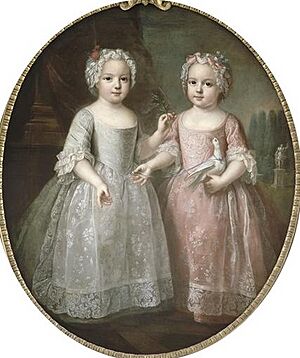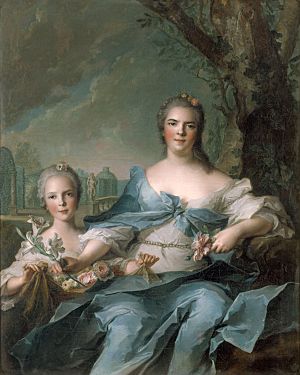Louise Élisabeth of France facts for kids
Quick facts for kids Louise Élisabeth of France |
|||||
|---|---|---|---|---|---|
| Madame Royale | |||||
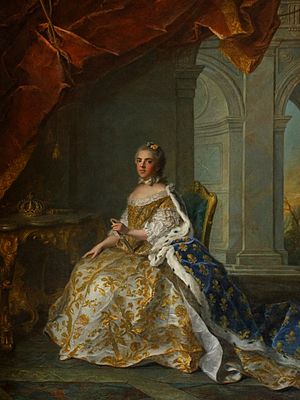
Posthumous portrait by Nattier, 1761
|
|||||
| Duchess consort of Parma, Piacenza and Guastalla | |||||
| Tenure | 18 October 1748 – 6 December 1759 | ||||
| Born | 14 August 1727 Palace of Versailles, Kingdom of France |
||||
| Died | 6 December 1759 (aged 32) Palace of Versailles, France |
||||
| Burial | Royal Basilica of Saint Denis | ||||
| Spouse | |||||
| Issue |
|
||||
|
|||||
| House | Bourbon | ||||
| Father | Louis XV | ||||
| Mother | Maria Leszczyńska | ||||
| Signature | |||||
| Styles of Louise Élisabeth, Duchess of Parma as consort |
|
|---|---|
| Reference style | Her Royal Highness |
| Spoken style | Your Royal Highness |
| Alternative style | Madame |
Marie Louise Élisabeth of France (born August 14, 1727 – died December 6, 1759) was a French princess. She was the oldest daughter of King Louis XV of France and Queen Maria Leszczyńska. She was also the older twin sister of Princess Henriette of France.
Élisabeth married Infante Philip of Spain. Philip became the Duke of Parma in 1748. He was her father's first cousin. Together, Élisabeth and Philip started the House of Bourbon-Parma. She was like the real ruler of the Duchy of Parma from 1748 to 1759.
Life Story
Early Years
Marie Louise Élisabeth and her twin sister Henriette were born at the Palace of Versailles. This happened on August 14, 1727. Their parents were King Louis XV of France and Queen Maria Leszczyńska.
They were baptized at Versailles in 1737. As a king's daughter, she was called a fille de France. At court, she was known as Madame Royale or Madame Élisabeth. Her family sometimes called her Babette.
Élisabeth grew up at Versailles with her twin and younger siblings. Her younger sisters, Victoire, Sophie, Thérèse, and Louise Marie, were sent to a special abbey. This was the Fontevraud Abbey in June 1738.
People said Élisabeth was not as pretty as her twin. But she was often described as lively and determined. She was known for being charming and intelligent.
In February 1739, when she was eleven, her engagement was announced. She was to marry Infante Philip of Spain. Philip was the third son of King Philip V of Spain.
This marriage continued a tradition of royal weddings between France and Spain. However, many at the French court were not happy. Philip was unlikely to become King of Spain. They thought a French princess should marry a future king.
Élisabeth herself felt her future was "less glorious" than she hoped. She was married by proxy at Versailles on August 26, 1739. After this, she was known as Madame Infanta in France.
When she left for Spain in September, her father, the king, was very sad. He rode with her for the first few miles. She met her husband, Philip, near Madrid. They married on October 25, 1739.
Life in Spain
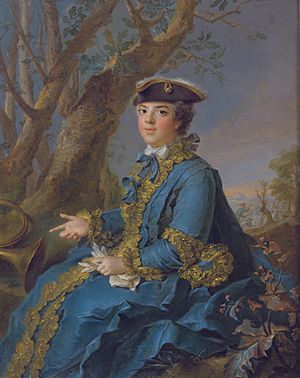
Élisabeth was very popular when she arrived in Spain. She quickly became "the idol of Madrid." She made a good impression on her father-in-law, King Philip V. Her husband, Prince Philip, also liked her.
However, her relationship with her mother-in-law, Queen Elisabeth, was not good. The Queen was upset that France did not pay Élisabeth's dowry. She also felt Élisabeth might take her influence over her son.
Élisabeth soon became very influential over Philip. Even though he was eight years older, he was shy and quiet. Élisabeth cared for him but treated him like a younger boy.
Élisabeth was ambitious and energetic. She wanted to improve her family's standing in Europe. She also wanted to make her son a prince worthy of his French ancestors.
She was not happy just being a prince's wife. She stayed in touch with the French court. She told her brother, the Dauphin, everything happening in Spain. By 1740, she had many contacts in France. She used them to gain a better position for herself and Philip.
Her twin sister, Henriette, usually avoided politics. But she worked hard for Élisabeth's goals. Her younger sister Adelaide also helped. The French ambassador in Madrid was very supportive.
In 1741, Philip joined the War of the Austrian Succession. It was hoped he could gain control of a duchy in Italy. Queen Elisabeth kept Philip in the war camp. She wanted to stop Élisabeth from becoming too close to him.
Despite their dislike, Élisabeth and her mother-in-law both wanted Philip to have a throne. They achieved this with the Treaty of Aix-la-Chapelle in 1748.
Duchess of Parma
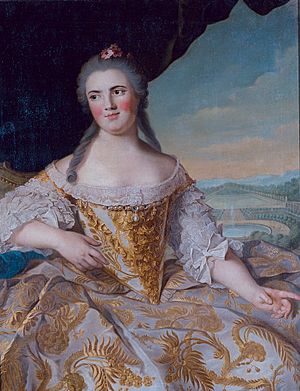
The Treaty of Aix-la-Chapelle ended the War of the Austrian Succession. In this treaty, Empress Maria Theresa gave the duchies of Parma, Piacenza, and Guastalla to Spain. King Louis XV of France helped make Philip the Duke of Parma.
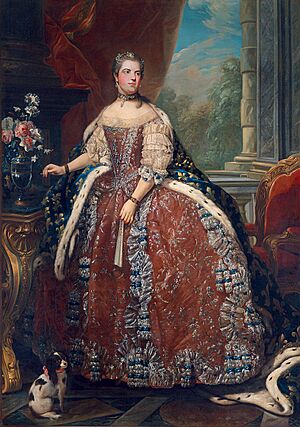
Élisabeth was happy with her new role. But she wanted her own money, separate from Spain. So, she went to the French court to ask her father for financial support.
Her twin sister and brother met her in Choisy. She arrived at Versailles on December 11, 1748. She brought a small group of Spanish attendants. The French court was surprised by her simple style. They said she seemed to have few clothes.
She was described as clever and practical. She focused on important state matters. One courtier called her "charming" with "piercing eyes." She spent most of her time with her father, the king. They discussed important business daily.
She succeeded in her goal. Her father gave two hundred thousand francs for the Duke of Parma. Her strong will worried Madame de Pompadour, the king's mistress. When Élisabeth left Versailles in October 1749, she took many new gowns. Her trip cost a lot of money.
In December 1749, Élisabeth arrived in Parma. Philip welcomed her, and there were public celebrations. In Parma, she and Philip lived in the Ducal Palace of Colorno. The palace needed a lot of work.
Élisabeth spent a lot of money to make the palace and court beautiful. She redesigned the residence. She also organized many court events and parties. She wanted to show the Duchy's importance. She even added a regiment of soldiers.
As Duchess of Parma, Élisabeth was very involved in government. Philip always asked her for advice. She always considered France's views. Most court officials were French, and French was spoken at court.
French influence in Parma was not popular. People were angry at both French and Spanish rulers. The Duchy also had many financial problems.
Élisabeth's twin sister Henriette died in 1752. Élisabeth returned to France in September. She visited Henriette's tomb at Saint-Denis. She stayed at Versailles for almost a year.
She worked with the duke de Noailles. He helped her with political discussions with her father. Élisabeth gave Louis XV a report on Parma's financial needs. France and Spain agreed to share the Duchy's expenses. This made French influence in Parma official. Élisabeth was praised for this agreement.

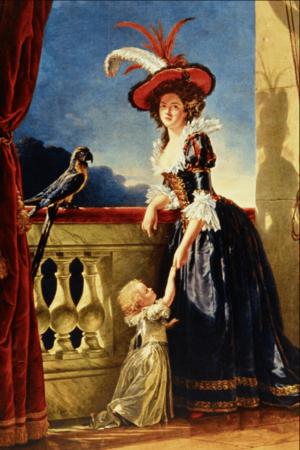
Élisabeth returned to Parma in October 1753. She appointed Guillaume du Tillot as chief minister. This helped her pro-French policies. She worked to free Parma from Spanish influence. She also wanted to secure a greater throne for her son.
She saw Spain as an enemy. She supported the Treaty of Versailles of 1756. This treaty allied France with Austria. It was suggested that Austria would give the Austrian Netherlands to Philip as a kingdom. This would be good for France.
Élisabeth returned to France in September 1757. She attended talks between France and Austria. She wanted Philip to rule the Austrian Netherlands. But she was not successful.
She became ill at Versailles. She died of smallpox on December 6, 1759. She was buried at Saint-Denis Basilica next to her twin, Henriette. Their tombs were later damaged during the French Revolution.
Children
- Isabella (1741–1763): She married the future Austrian emperor Joseph II.
- Ferdinand (1751–1802): He became Duke of Parma after his father. He married Archduchess Maria Amalia of Austria.
- Maria Luisa (1751–1819): She married her cousin, Infante Charles of Spain. She later became the Queen consort of Spain.
See also
 In Spanish: Luisa Isabel de Francia para niños
In Spanish: Luisa Isabel de Francia para niños


